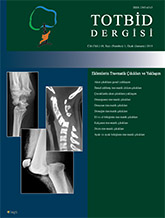
The increase in the average life expectancy, overall life quality, the scientific and technological developments leaded to an increase in the number of total knee arthroplasty. Today, the 10-year survival rate of most TKA implants hit 90%. Numerous factors play a role in longterm painless, functional total knee arthroplasty with high survival, including patient selection, prosthesis design, proper alignment restoration, appropriate component positioning, ligament balancing and the adequate fixation. Two goals under the control of the surgeon during these surgical procedures are;
1) to obtain the adequate soft tissue balance by
2) aligning lower extremity, knee and components appropriately.
Malalingment may lead to failure and the need for revision of total knee arthroplasty in the early or late period. On the other hand, there are various conditions that decrease the quality of total knee arthroplasty and cause dissatisfaction in patients yet not concluding in revision of total knee arthroplasty which are associated with mistakes and deficiencies related to the alingment. In order to determine the appropriate lower extremity and knee alignment during total knee arthroplasty, a normal alignment must be understood. Appreciating the normal alignment of the lower limb and knee biomechanics will enable the surgeon to perform appropriate bone cutting and soft tissue release, and make more accurate decisions about the determination of the components at the appropriate size and placement. In this section, settlement, dimension and alignment problems of lower extremity, knee and components coped during and after total knee arthroplasty, as well as possible precautions and suggestions will be discussed.